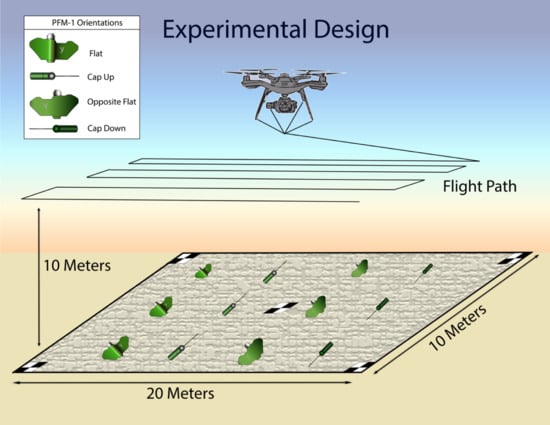Detection and Identification of Remnant PFM-1 ‘Butterfly Mines’ with a UAV-Based Thermal-Imaging Protocol
Abstract
1. Introduction
2. Materials and Methods
3. Results
4. Discussion
5. Conclusions
Author Contributions
Funding
Acknowledgments
Conflicts of Interest
References
- Bello, R. Literature review on landmines and detection methods. Front. Sci. 2013, 3, 27–42. [Google Scholar]
- Roberts, S.; Williams, J. After the Guns Fall Silent: The Enduring Legacy of Landmines; Oxfam: Oxford, UK, 1995. [Google Scholar]
- Bruschini, C.; Gros, B.; Guerne, F.; Piece, P.Y.; Carmona, O. Ground penetrating radar and imaging metal detector for antipersonnel mine detection. J. Appl. Geophys. 1998, 40, 59–71. [Google Scholar] [CrossRef]
- Gooneratne, C.P.; Mukhopahyay, S.C.; Gupta, G.S. A review of sensing technologies for landmine detection: Unmanned vehicle based approach. In Proceedings of the 2nd International Conference on Autonomous Robots and Agents, Palmerston North, New Zealand, 13–15 December 2004; pp. 401–407. [Google Scholar]
- Schreiner, K. Landmine detection research pushes forward, despite challenges. IEEE Intell. Syst. 2002, 17, 4–7. [Google Scholar] [CrossRef]
- Stover, E.R.I.C.; Cobey, J.C.; Fine, J. The public health effects of land mines: Long-term consequences for civilians. War Public Health 1997, 137–146. [Google Scholar]
- Dolgov, R. Landmines in Russia and the Former Soviet Union: A Lethal Epidemic. Med. Glob. Surviv. 2001, 7, 38–42. [Google Scholar]
- Fraser, M. Landmines: An ongoing environmental health problem for the children of Afghanistan. J. Rural Remote Environ. Health 2003, 2, 76–89. [Google Scholar]
- Strada, G. The horror of land mines. Sci. Am. 1996, 274, 40–45. [Google Scholar] [CrossRef]
- Urban, M. Nine: 1986. In War in Afghanistan; Palgrave Macmillan: London, UK, 1990; pp. 186–211. [Google Scholar]
- De Smet, T.; Nikulin, A. Catching “butterflies” in the morning: A new methodology for rapid detection of aerially deployed plastic land mines from UAVs. Lead. Edge 2018, 37, 367–371. [Google Scholar] [CrossRef]
- Hughes, G. The Soviet–Afghan War, 1978–1989: An Overview. Defence Stud. 2008, 8, 326–350. [Google Scholar] [CrossRef]
- Harutyunyan, A. Demining in Remote Areas of Northern Afghanistan. J. Conv. Weapons Destr. 2014, 18, 10. [Google Scholar]
- MacDonald, J.; Lockwood, J.R.; McFee, J.; Altshuler, T.; Broach, T. Alternatives for Landmine Detection; No. RAND/MR-1608-OSTP; Rand Corp: Santa Monica, CA, USA, 2003. [Google Scholar]
- Harmon, R.S.; DeLucia, F.C.; LaPointe, A.; Winkel, R.J.; Miziolek, A.W. LIBS for landmine detection and discrimination. Anal. Bioanal. Chem. 2006, 385, 1140–1148. [Google Scholar] [CrossRef] [PubMed]
- Asch, T.; Moulton, C.; Smith, D.V. Classification of MEC with the ALLTEM at Camp Stanley, Texas. In Proceedings of the 81st Annual International Meeting, San Antonio, TX, USA, 18–22 September 2011; pp. 1363–1367. [Google Scholar] [CrossRef]
- Igel, J.; Preetz, H.; Takahashi, K.; Loewer, M. Landmine and UXO detection using EMI and GPR–limitations due to the influence of the soil. First Break 2013, 31, 43–51. [Google Scholar]
- Daniels, D.J. Ground penetrating radar. In Encyclopedia of RF and Microwave Engineering; Wiley: Hoboken, NJ, USA, 2005. [Google Scholar]
- Metwaly, M. Detection of metallic and plastic landmines using the GPR and 2-D resistivity techniques. Nat. Hazards Earth Syst. Sci. 2007, 7, 755–763. [Google Scholar] [CrossRef]
- Daniels, D.J. Ground penetrating radar for buried landmine and IED detection. In Unexploded Ordnance Detection and Mitigation; Springer: Dordrecht, The Netherlands, 2009; pp. 89–111. [Google Scholar]
- Giannakis, I.; Xu, S.; Aubry, P.; Yarovoy, A.; Sala, J. Signal processing for landmine detection using ground penetrating radar. In Proceedings of the 2016 IEEE International Geoscience and Remote Sensing Symposium (IGARSS), Beijing, China, 10–15 July 2016; pp. 7442–7445. [Google Scholar]
- Lombardi, F.; Griffiths, H.D.; Wright, L.; Balleri, A. Dependence of landmine radar signature on aspect angle. IET Radar Sonar Navig. 2017, 11, 892–902. [Google Scholar] [CrossRef]
- Zanzi, L.; Lualdi, M.; Braun, H.M.; Borisch, W.; Triltzsch, G. Ultrahigh-frequency radar sensor for humanitarian demining tested on different scenarios in 3D imaging mode. In Proceedings of the Ninth International Conference on Ground Penetrating Radar, Santa Barbara, CA, USA, 29 April–2 May 2002. [Google Scholar]
- Walls, R.; Brown, T.; Clodfelter, F.; Coors, J.; Laudato, S.; Lauziere, S.; Patrikar, A.; Poole, M.; Price, M. Ground penetrating radar field evaluation in Angola. In Proceedings of the Detection and Remediation Technologies for Mines and Minelike Targets XI, Orlando, FL, USA, 17–21 April 2006; International Society for Optics and Photonics: Bellingham, WA, USA, 2006; Volume 6217. [Google Scholar]
- Lualdi, M.; Lombardi, F. Combining orthogonal polarization for elongated target detection with GPR. J. Geophys. Eng. 2014, 11, 055006. [Google Scholar] [CrossRef]
- Paglieroni, D.W.; Chambers, D.H.; Mast, J.E.; Bond, S.W.; Beer, N.R. Imaging modes for ground penetrating radar and their relation to detection performance. IEEE J. Sel. Top. Appl. Earth Obs. Remote Sens. 2015, 8, 1132–1144. [Google Scholar] [CrossRef]
- Sabatier, J.M.; Xiang, N. An investigation of acoustic-to-seismic coupling to detect buried anti-tank landmines. IEEE Trans. Geosci. Remote Sens. 2001, 39, 1146–1154. [Google Scholar] [CrossRef]
- Xiang, N.; Sabatier, J.M. An experimental study on antipersonnel landmine detection using acoustic-to-seismic coupling. J. Acoust. Soc. Am. 2003, 113, 1333–1341. [Google Scholar] [CrossRef] [PubMed]
- Donskoy, D.; Ekimov, A.; Sedunov, N.; Tsionskiy, M. Nonlinear seismo-acoustic land mine detection and discrimination. J. Acoust. Soc. Am. 2002, 111, 2705–2714. [Google Scholar] [CrossRef] [PubMed]
- Zagrai, A.; Donskoy, D.; Ekimov, A. Structural vibrations of buried land mines. J. Acoust. Soc. Am. 2005, 118, 3619–3628. [Google Scholar] [CrossRef]
- Kasban, H.; Zahran, O.; El-Kordy, M.; Elaraby, S.M.; El-Samie, F.A. Automatic object detection from acoustic to seismic landmine images. In Proceedings of the 2008 International Conference on Computer and Engineer systems, Cairo, Egypt, 25–27 November 2008; pp. 193–198. [Google Scholar]
- Cherkauer, K.A.; Burges, S.J.; Handcock, R.N.; Kay, J.E.; Kampf, S.K.; Gillespie, A.R. Assessing satellite-based and aircraft based remote thermal infrared remote sensing for monitoring Pacific Northwest river temperature 1. J. Am. Water Resour. Assoc. 2005, 41, 1149–1159. [Google Scholar] [CrossRef]
- Zappa, C.J.; Jessup, A.T. High-resolution airborne infrared measurements of ocean skin temperatures. IEEE Trans. Geosci. Remote 2005, 2, 146–150. [Google Scholar] [CrossRef]
- Yu, Y.; Rothrock, D.A. Thin ice thickness from satellite thermal imagery. J. Geophys. Res. Oceans 1996, 101, 25753–25766. [Google Scholar] [CrossRef]
- Rivoire, L.; Birner, T.; Knaff, J.A. Evolution of the upper-level thermal structure in tropical cyclones. Geophys. Res. Lett. 2016, 43, 10530–10537. [Google Scholar] [CrossRef]
- Kossin, J.P.; Knaff, J.A.; Berger, H.I.; Herndon, D.C.; Cram, T.A.; Velden, C.S.; Murnane, R.J.; Hawkins, J.D. Estimating Hurricane Wind Structure in the Absence of Aircraft Reconnaissance. Weather Forecast. 2007, 22, 89–101. [Google Scholar] [CrossRef]
- Naugle, D.E.; Jenks, J.A.; Kernohan, B.J. Use of thermal infared sensing to estimate density of white-tailed deer. Wildl. Soci. Bull. 1996, 24, 37–43. [Google Scholar]
- Ortega-Farias, S.; Ortega-Salazar, S.; Poblete, T.; Kilic, A.; Allen, R.; Polblete-Echeverria, C.; Ahumada-Orellana, L.; Zungia, M.; Sepulveda, D. Estimation of Energy Balance Components over a Drip-Irrigated Olive Orchard Using Thermal and Multispectral Cameras Placed on a Helicopter-Based Unmanned Aerial Vehicle (UAV). Remote Sens. 2016, 8, 638. [Google Scholar] [CrossRef]
- Bendig, J.; Yu, K.; Aasen, H.; Bolten, A.; Bennertz, S.; Broscheit, J.; Gnyp, M.L.; Bareth, G. Combining UAV-based plant height from crop surface models, visible, and near infrared vegetation indices for biomass monitoring in barley. Int. J. Appl. Earth Obs. Geoinf. 2015, 39, 79–87. [Google Scholar] [CrossRef]
- Sepuleda-Reyes, D.; Ingram, B.; Bardeen, M.; Zungia, M.; Ortega-Farias, S.; Poblete-Echeverria, C. Selecting Canopy Zones and Thresholding Approaches to Assess Grapevine Water Status by Using Aerial and Ground-Based Thermal Imaging. Remote Sens. 2016, 8, 622. [Google Scholar]
- Bellvert, J.; Zarco-Tejada, P.J.; Girona, J.; Fereres, E. Mapping crop water stress index in a ‘Pinot-noir’ vineyard: Comparing ground measurements with thermal remote sensing imagery from an unmanned aerial vehicle. Precis. Agric. 2014, 15, 361–376. [Google Scholar] [CrossRef]
- Sparks, R.S.J.; Biggs, J.; Neuberg, J.W. Monitoring Volcanoes. Science 2012, 335, 1310–1311. [Google Scholar] [CrossRef] [PubMed]
- McGonigle, A.J.S.; Aiuppa, A.; Giudice, G.; Tamburello, G.; Hodson, A.J.; Gurrieri, S. Unmanned aerial vehicle measurements of volcanic carbon dioxide fluxes. Geophys. Res. Lett. 2008, 35. [Google Scholar] [CrossRef]
- Poirier, N.; Hautefeuille, F.; Calastrenc, C. Low Altitude Thermal Survey by Means of an Automated Unmanned Aerial Vehicle for the Detection of Archaeological Buried Structures. Archeol. Prospect. 2013, 20, 303–307. [Google Scholar] [CrossRef]
- Giardini, M.J. A history of NASA remote sensing contribution to archaeology. J. Archeol. Sci. 2011, 38, 2003–2009. [Google Scholar] [CrossRef]
- Pajares, G. Overview and Current Status of Remote Sensing Applications Based on Unmanned Aerial Vehicles (UAVs). Photogramm. Eng. Remote Sens. 2015, 81, 281–330. [Google Scholar] [CrossRef]
- Price, S.R.; Anderson, D.T.; Luke, R.H.; Stone, K.; Keller, J.M. Automatic detection system for buried explosive hazards in FL-LWIR based on soft feature extraction using a bank of Gabor energy filters. In Proceedings of the SPIE 8709, Detection and Sensing of Mines, Explosive Objects, and Obscured Targets XVIII, Baltimore, MD, USA, 29 April–3 May 2013. [Google Scholar]
- Popescu, M.; Paino, A.; Stone, K.; Keller, J.M. Detection of Buried Objects in FLIR Imaging Using mathematical morphology and SYV. In Proceedings of the 2012 IEEE Symposium on Computational Intelligence for Security and Defence Applications (CISDA), Ottawa, ON, Canada, 11–13 July 2012; pp. 1–5. [Google Scholar]
- Yao, F.; Shao, G.; Sekmen, A.; Malkani, M. Real-Time Multiple Moving Targets Detection from Airborne IR Imagery by Dynamic Gabor Filter and Dynamic Gaussian Detector. EURASIP J. Image Video Process. 2010, 2010, 124681. [Google Scholar] [CrossRef]
- Deans, J.; Gerhard, J.; Carter, L.J. Analysis of a thermal imaging method for landmine detection, using infrared heating of the sand surface. Infrared Phys. Technol. 2006, 48, 202–216. [Google Scholar] [CrossRef]
- Thành, N.T.; Sahli, H.; Hào, D.N. Infrared Thermography for Buried Landmine Detect: Inverse Problem Setting. IEEE Trans. Geosci. Remote Sens. 2008, 46, 3987–4004. [Google Scholar] [CrossRef]
- Smits, K.M.; Cihan, A.; Sakaki, T.; Howington, S.E. Soil Moisture and Thermal Behavior in the Vicinity of Buried Objects Affecting Remote Sensing Detection. IEEE Trans. Geosci. Remote Sens. 2013, 51, 2675–2688. [Google Scholar] [CrossRef]
- Agarwal, S.; Sriram, P.; Palit, P.P.; Mitchell, O.R. Algorithms for IR-imagery-based airborne landmine and minefield detection. In Proceedings of the SPIE—Detection and Remediation of Mine and Minelike Targets VI, Orlando, FL, USA, 16–20 April 2001; Volume 4394, pp. 284–295. [Google Scholar]
- De Smet, T.S.; Nikulin, A.; Frazer, W.; Baur, J.; Abramowitz, J.; Finan, D.; Aglietti, N. Drones and “Butterflies”: A low cost UAV System for Rapid Detection and Identification of Unconventional Minefields. J. Conv. Weapons Destr. 2018, 22. in press. [Google Scholar]
- Sabol, D.E.; Gillespie, A.R.; McDonald, E.; Danillina, I. Differential thermal inertia of geological surfaces. In Proceedings of the 2nd Annual International Symposium of Recent Advances in Quantitative Remote Sensing, Torrent, Spain, 25–29 September 2006; pp. 25–29. [Google Scholar]
- Hijmans, R.J.; van Etten, J. Raster: Geographic Analysis and Modeling with Raster Data; R Package Version 2.0-12; R Foundation: Vienna, Austria, 2017. [Google Scholar]
- World Bank. Average Precipitation in Depth (mm per Year); Food and Agriculture Organization: Rome, Italy, 2014. [Google Scholar]
- Pantuso, F.P. The path to affordable and available 640x480 uncooled FPAs. In Proceedings of the Infrared Technology and Applications XXXI, Orlando, FL, USA, 28 March–1 April 2005; pp. 539–544. [Google Scholar]
- Alford, B.; Curran, E.; Cole, S. Determining the Value of UAVs in Iraq. J. Conv. Weapons Destr. 2018, 22, 8. [Google Scholar]
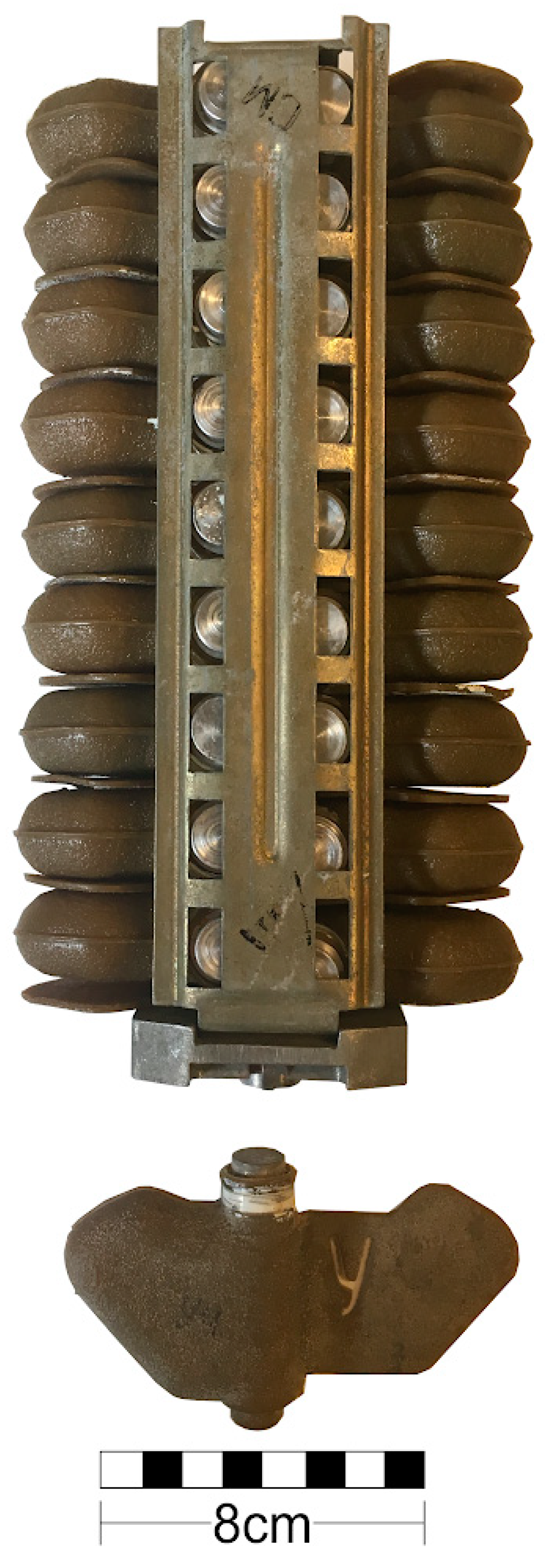
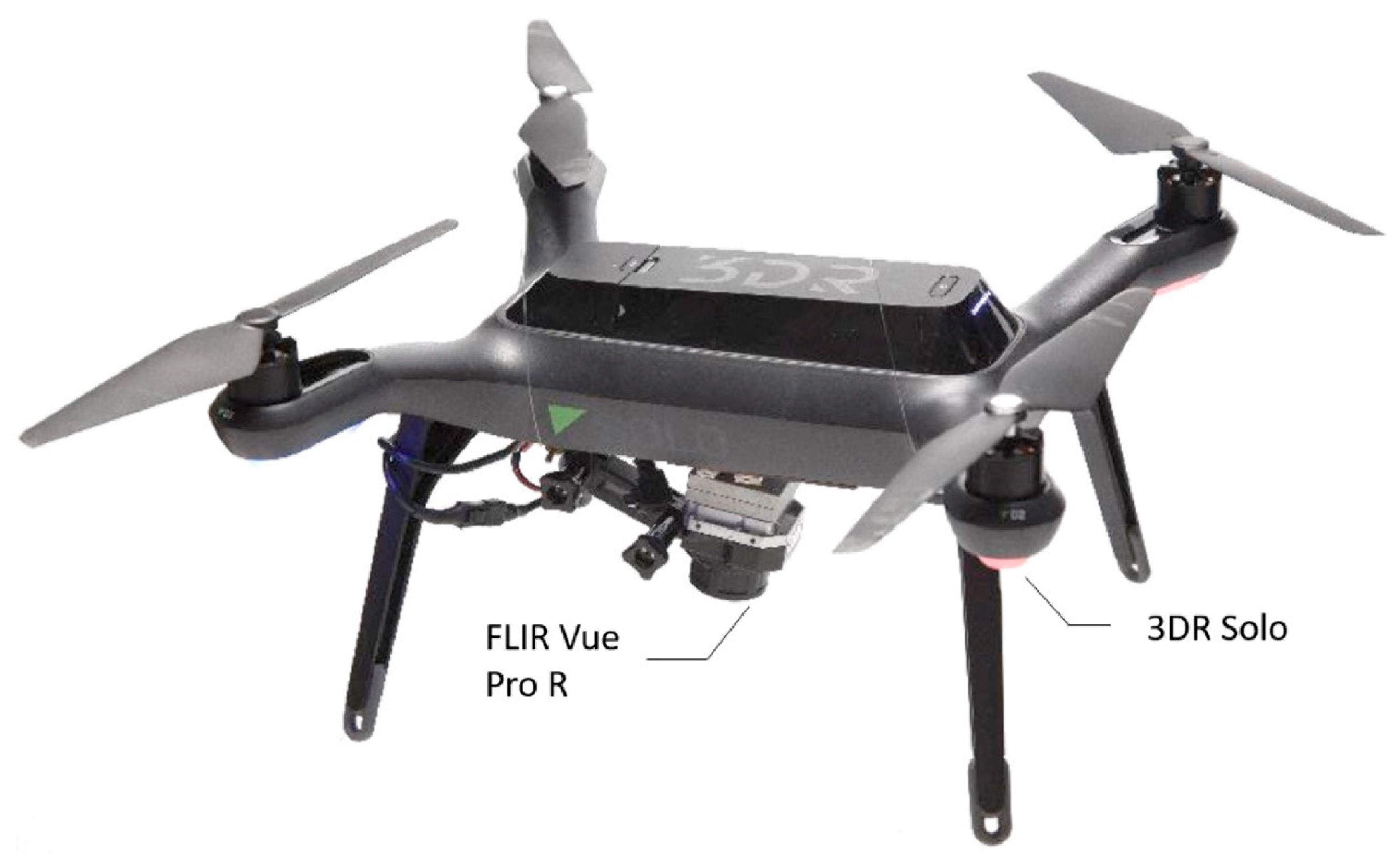
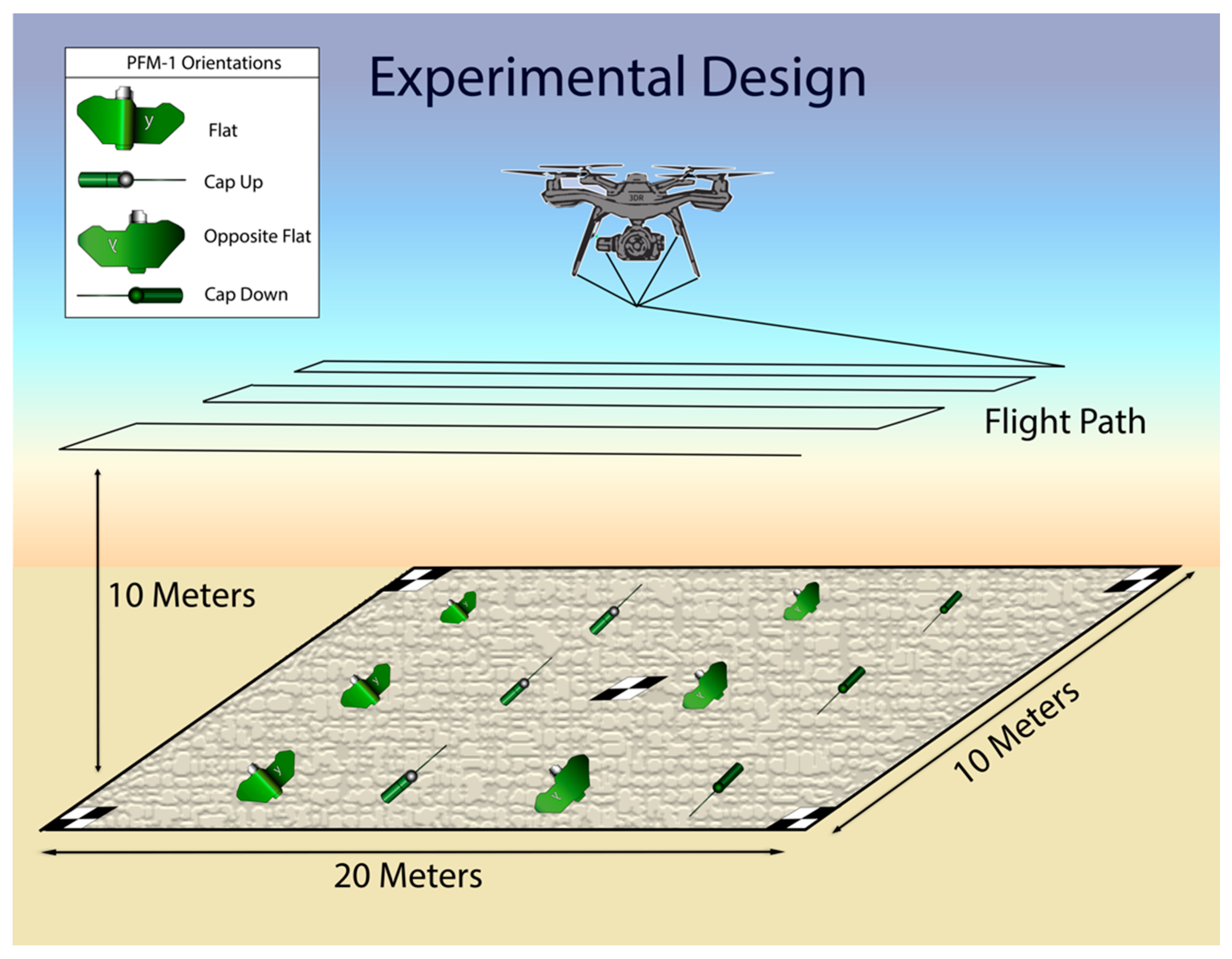
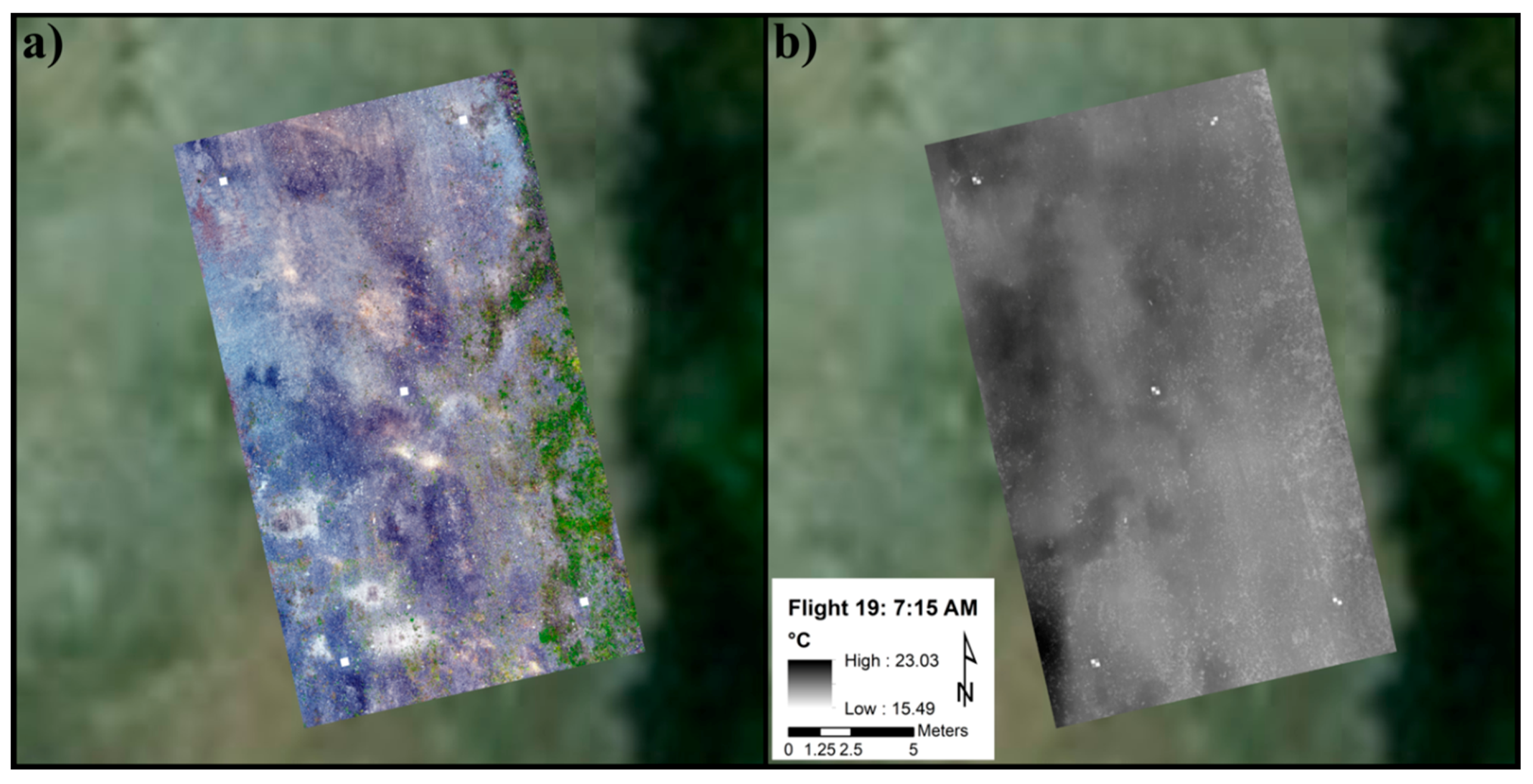
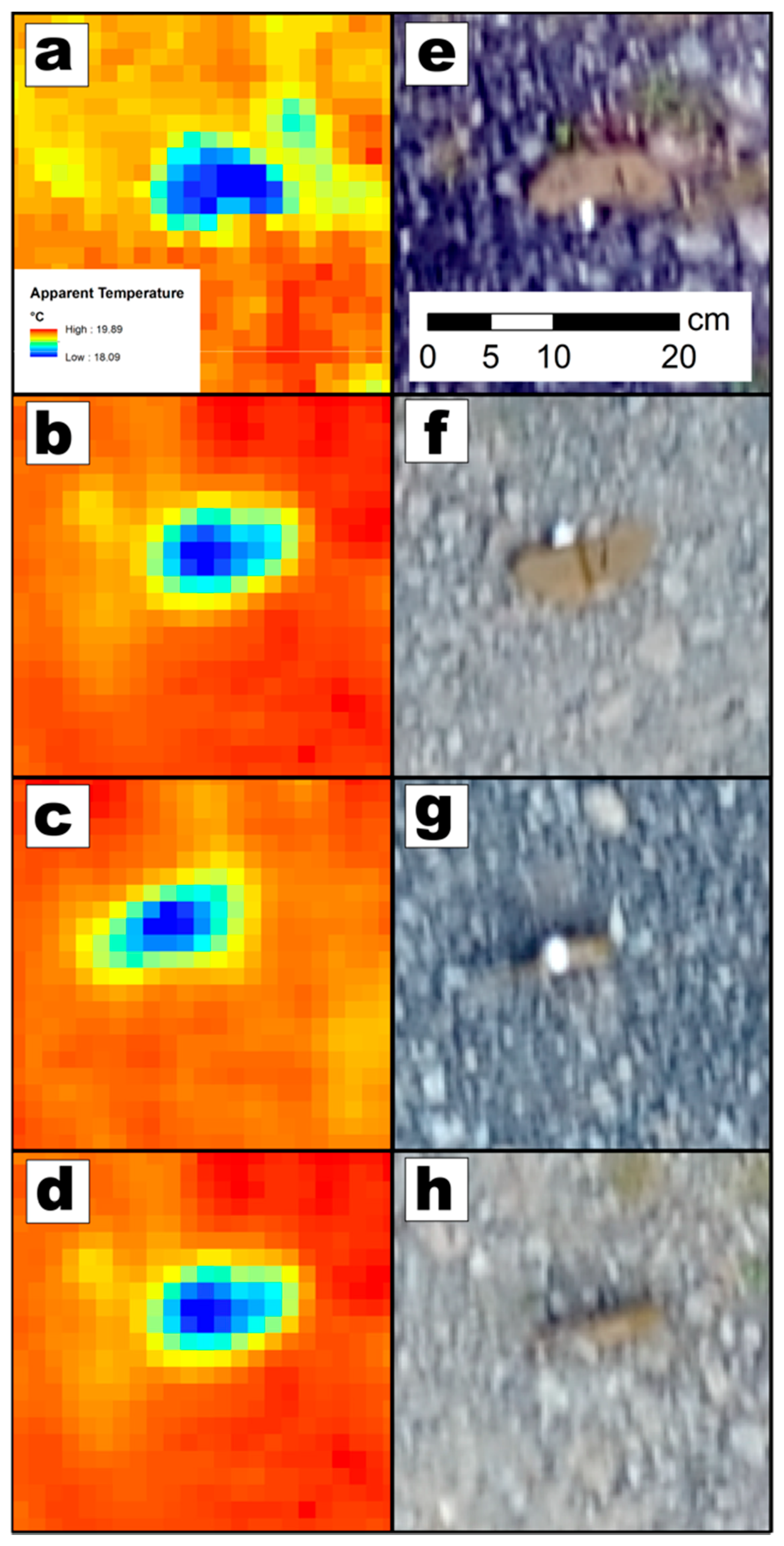
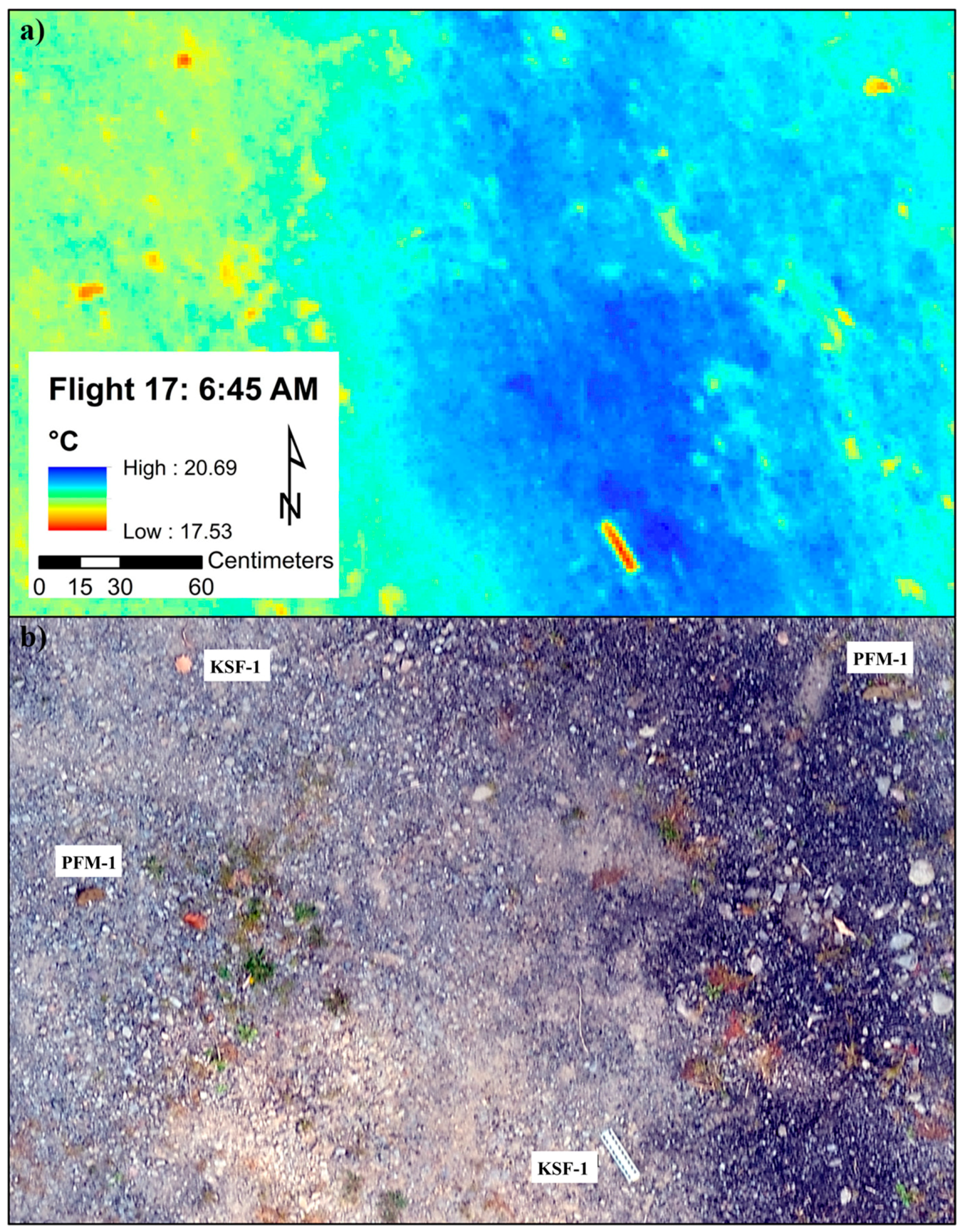
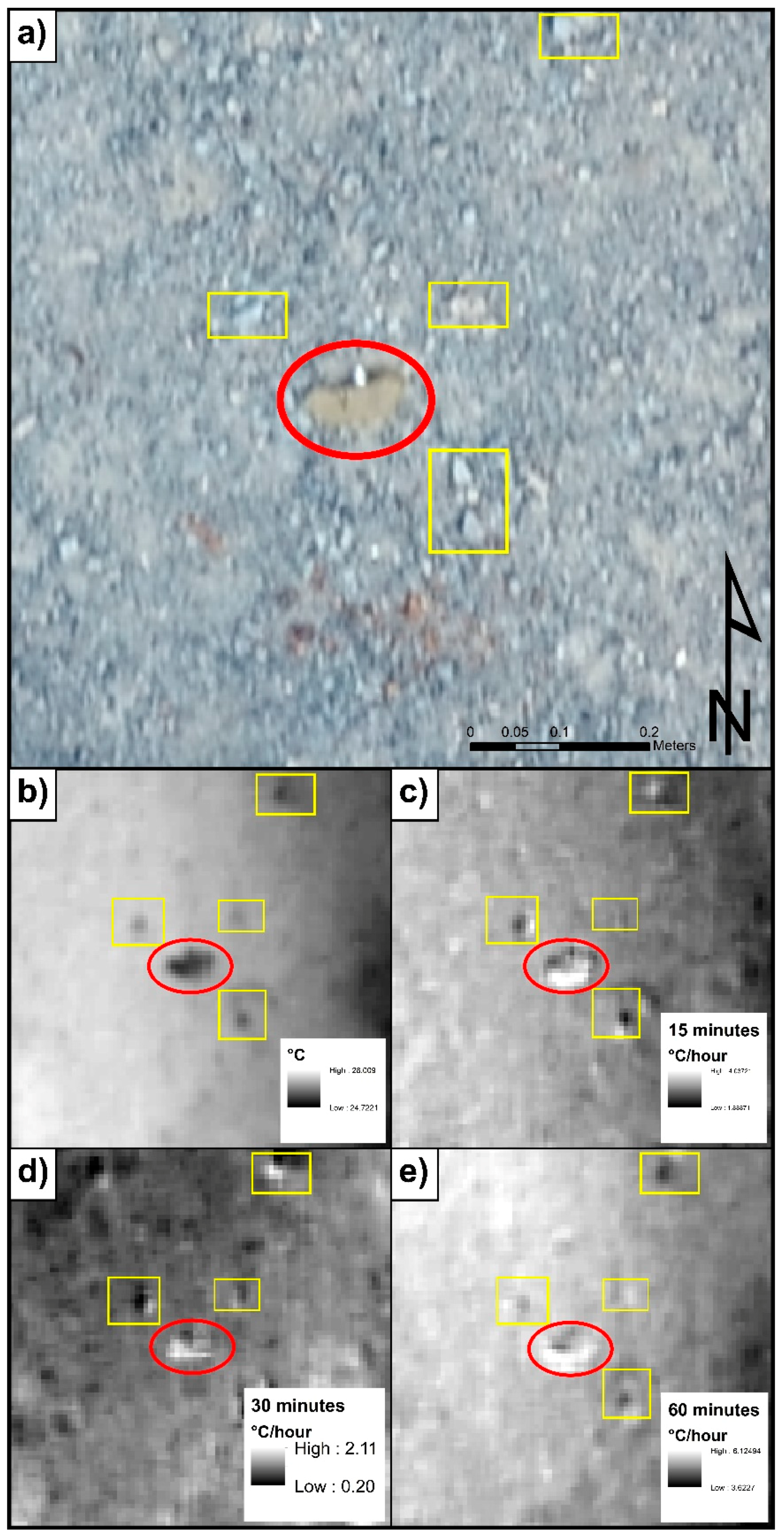
© 2018 by the authors. Licensee MDPI, Basel, Switzerland. This article is an open access article distributed under the terms and conditions of the Creative Commons Attribution (CC BY) license (http://creativecommons.org/licenses/by/4.0/).
Share and Cite
Nikulin, A.; De Smet, T.S.; Baur, J.; Frazer, W.D.; Abramowitz, J.C. Detection and Identification of Remnant PFM-1 ‘Butterfly Mines’ with a UAV-Based Thermal-Imaging Protocol. Remote Sens. 2018, 10, 1672. https://doi.org/10.3390/rs10111672
Nikulin A, De Smet TS, Baur J, Frazer WD, Abramowitz JC. Detection and Identification of Remnant PFM-1 ‘Butterfly Mines’ with a UAV-Based Thermal-Imaging Protocol. Remote Sensing. 2018; 10(11):1672. https://doi.org/10.3390/rs10111672
Chicago/Turabian StyleNikulin, Alex, Timothy S. De Smet, Jasper Baur, William D. Frazer, and Jacob C. Abramowitz. 2018. "Detection and Identification of Remnant PFM-1 ‘Butterfly Mines’ with a UAV-Based Thermal-Imaging Protocol" Remote Sensing 10, no. 11: 1672. https://doi.org/10.3390/rs10111672
APA StyleNikulin, A., De Smet, T. S., Baur, J., Frazer, W. D., & Abramowitz, J. C. (2018). Detection and Identification of Remnant PFM-1 ‘Butterfly Mines’ with a UAV-Based Thermal-Imaging Protocol. Remote Sensing, 10(11), 1672. https://doi.org/10.3390/rs10111672



